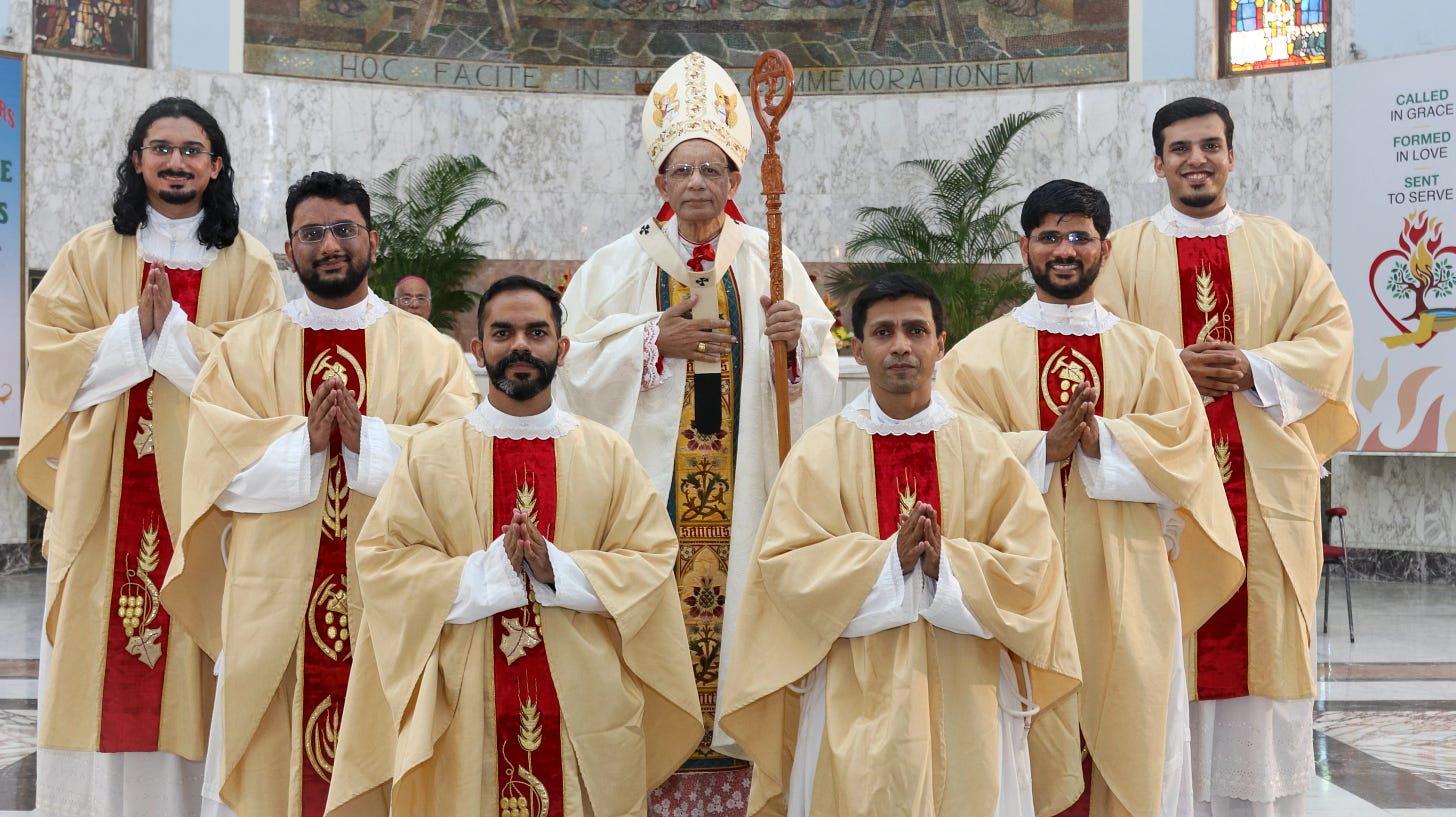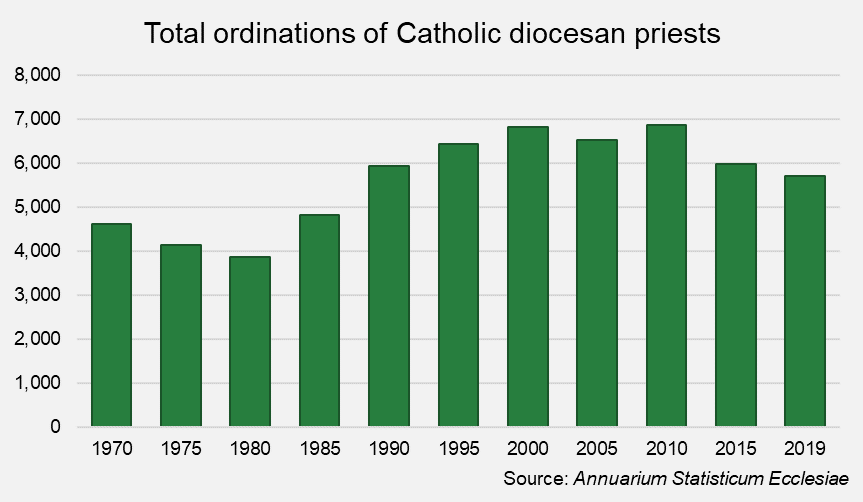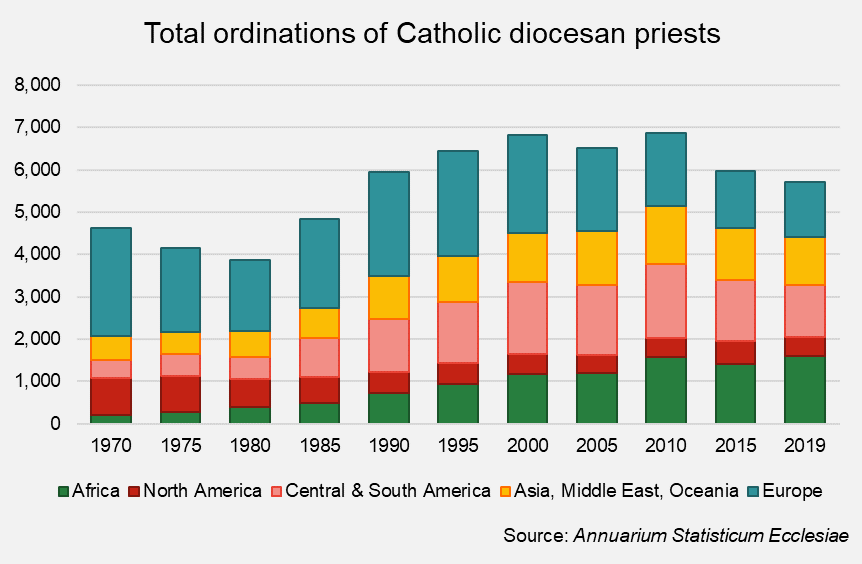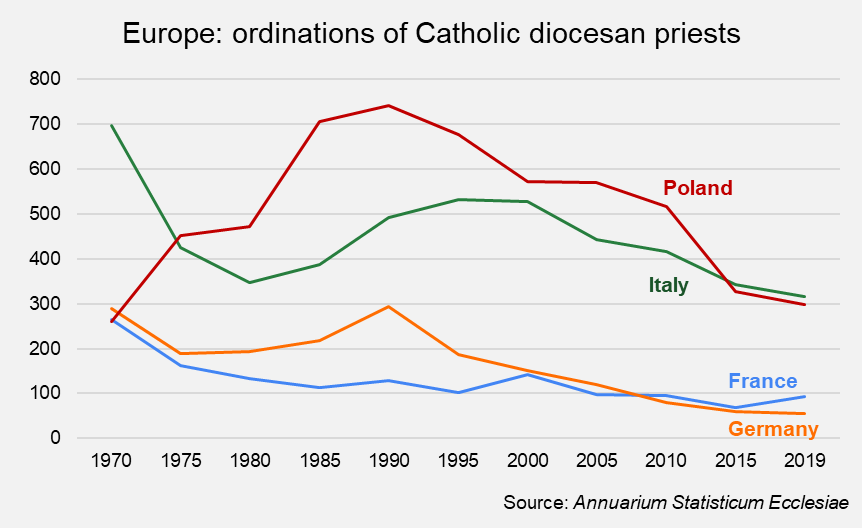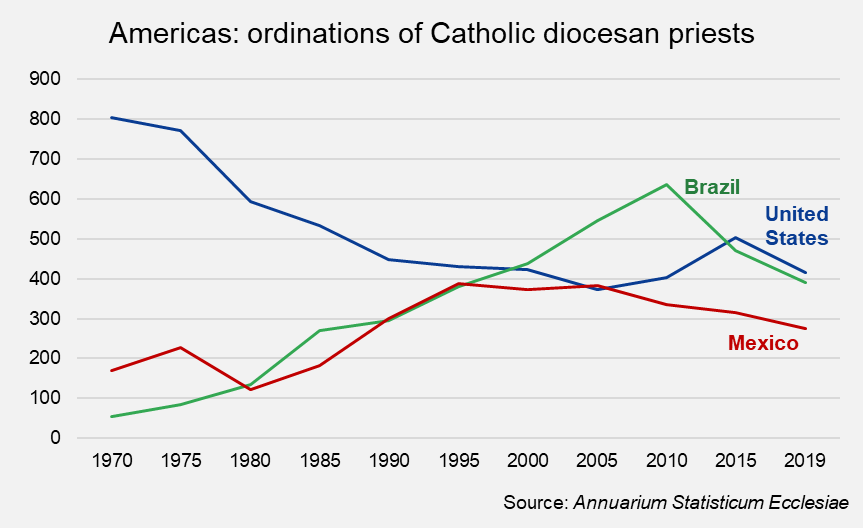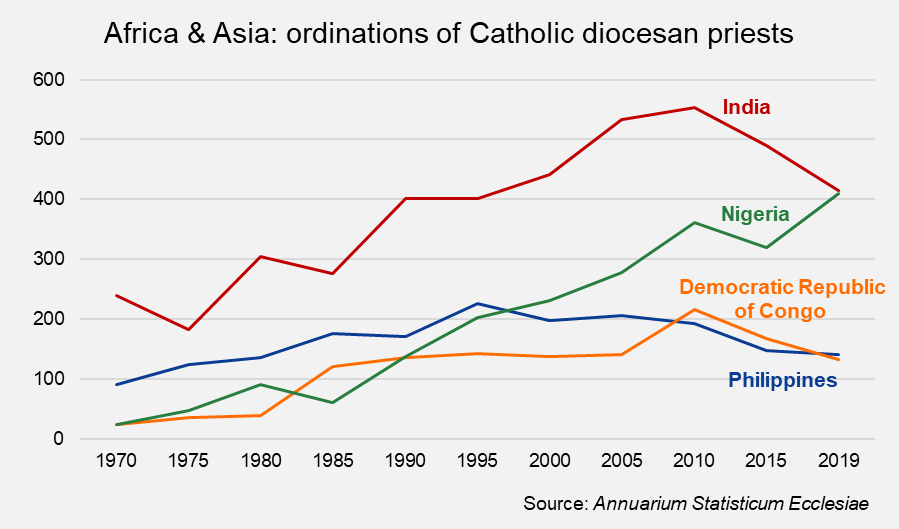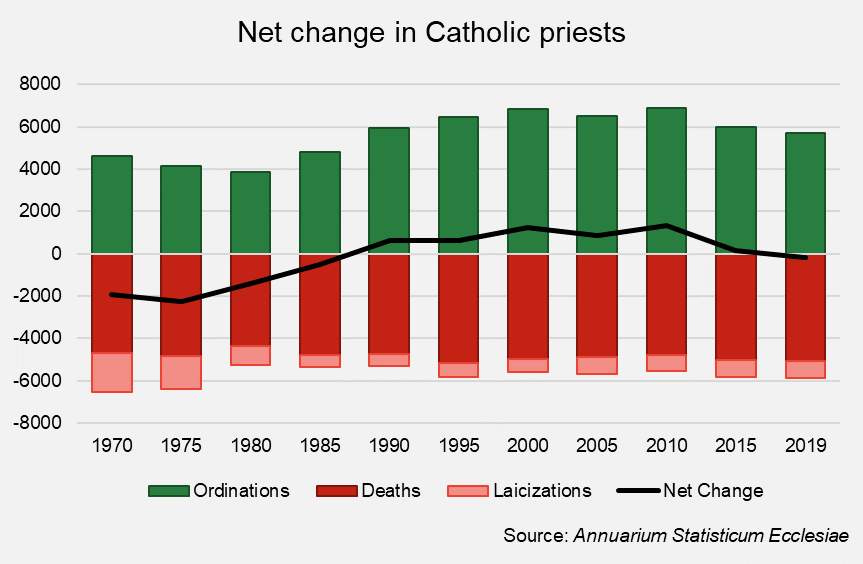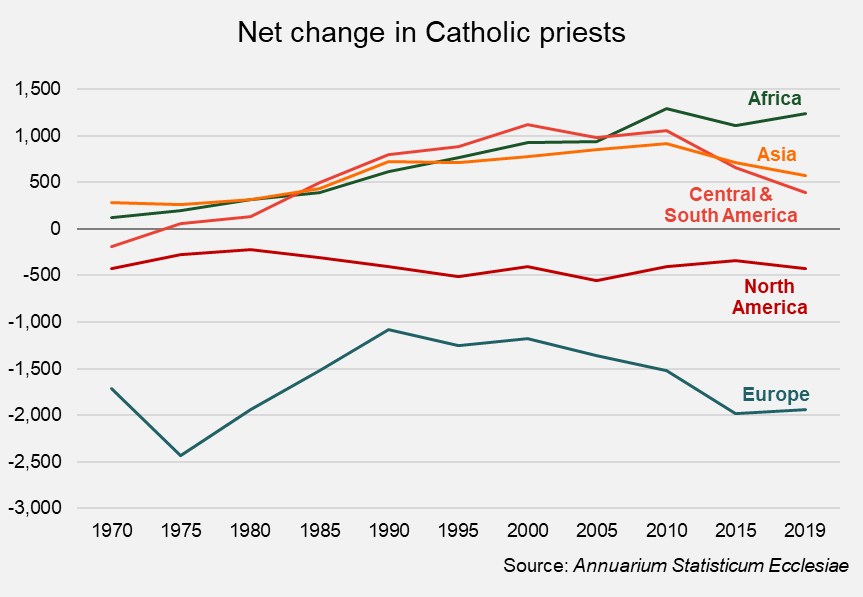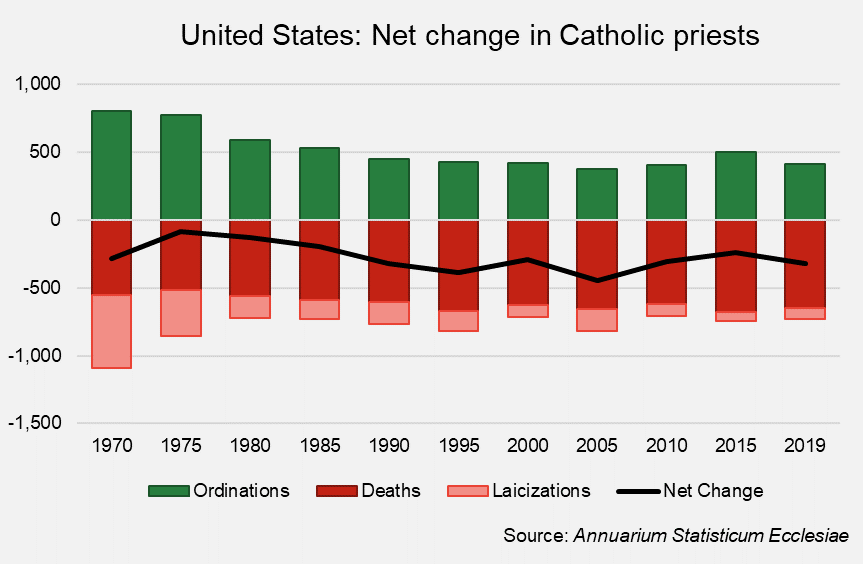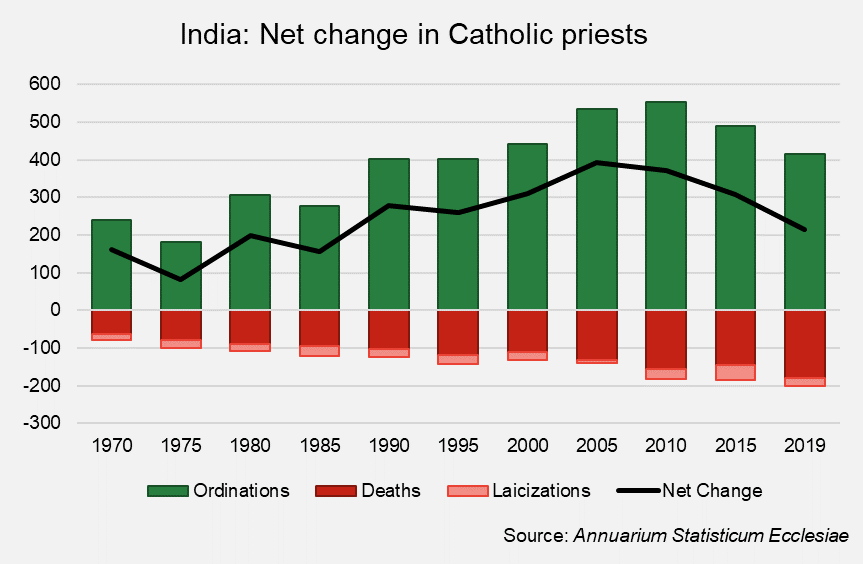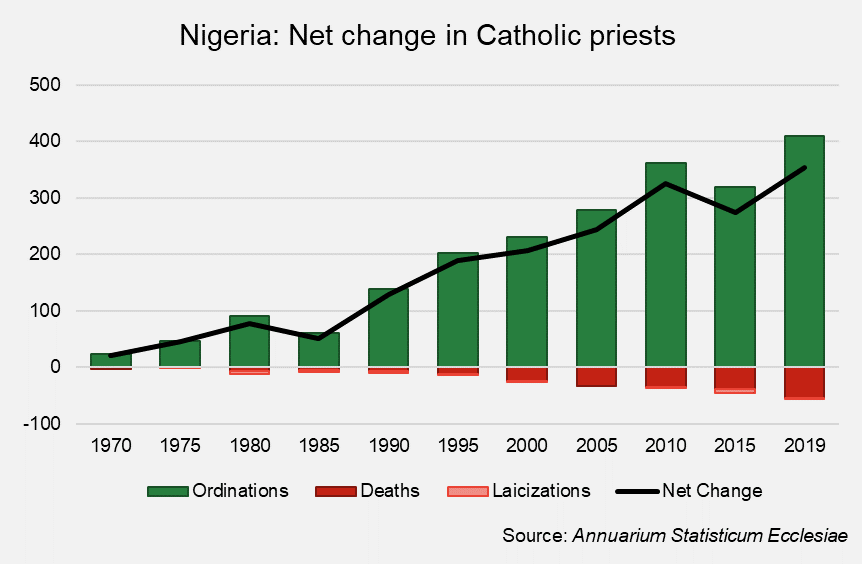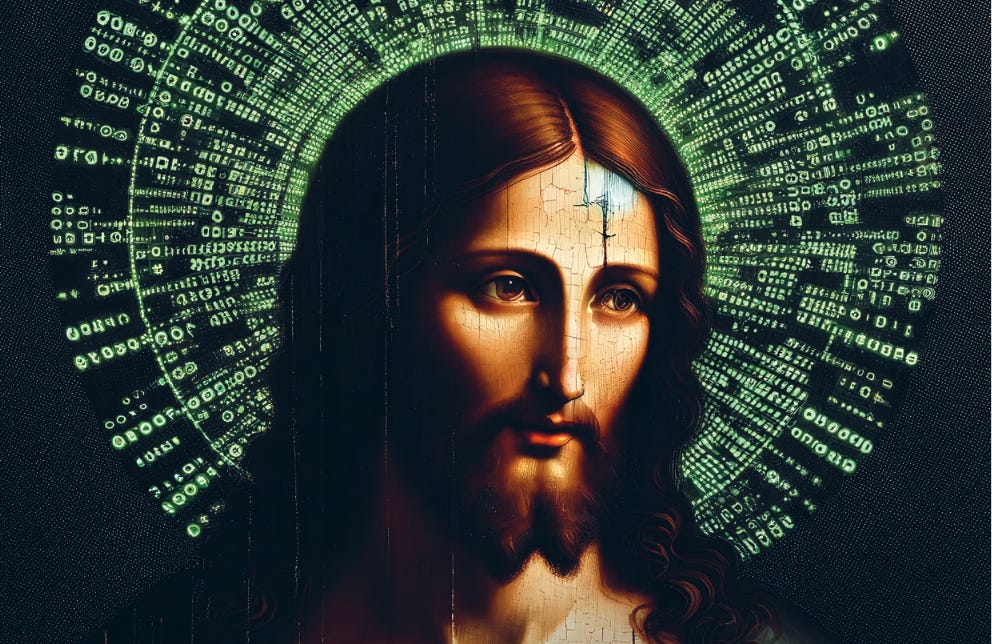While ordinations to the diocesan priesthood are on the rise in some parts of the world, they’re also falling fast in some traditionally Catholic countries.
And while a “vocations crisis” might be discussed most often in the United States, where more than one-third of diocesan priests are currently in retirement, the global picture of diocesan priestly ordinations points to changing trends and dynamics in the Catholic Church.
The number of priests around the world is holding steady, but the Catholic population is growing — which suggests a need for more priests, even in some of the most vibrant parts of the world.
The Pillar looks at the numbers.
The big picture
Since 1970, the Vatican has compiled an annual handbook of Church statistics which tracks ordinations to the diocesan priesthood.
The highest number of ordinations to the diocesan priesthood in the global Church since 1970 came in the decade between 2000 and 2010, when the Church ordained around 6,800 men annually as diocesan priests.
Between 1970 and 2019, the regional breakdown of diocesan priestly ordinations has changed dramatically.
In 1970, Europe accounted for 55% of all the Church’s ordinations to the diocesan priesthood. By 2019, the absolute number of men ordained in Europe had dropped by nearly 50%, and Europeans made up only 23% of all ordinations — European diocesan priesthood ordinations were outnumbered by Africans, who made up 28%.
The number of diocesan priests ordained in North America dropped 50% between 1970 and 2000, but has since leveled off.
In Central and South America, as well as in Asia, the number of diocesan priestly ordinations increased dramatically from 1970 to 2010, but has since begun to drop.
The Church in Europe
Within Europe in particular, there is a great deal of variation between countries.
Italy saw a 50% decline in diocesan priestly ordinations from 1970 to 1980, some increases in the 1990s, and then a new period of decline.
Poland saw a rapid increase in diocesan ordinations during the 1970s and 1980s, peaking around 1990, as the country freed itself from communism.
But the number of diocesan priestly ordinations in Poland has fallen over the last 30 years. In 2019 there were 298 men ordained priests, less than half the 741 who were ordained in 1990.
In 1970, France and Germany each had nearly 300 men ordained to be diocesan priests.
Since that time, ordinations in both countries have declined, though Germany saw an increase in ordinations during the waning years of communist rule, peaking in 1989 and 1990 as the Berlin Wall fell and Germany was reunited.
In 2019, France ordained 94 new diocesan priests, while Germany ordained 55.
The Americas
The United States has experienced a different ordinations trend from what the Catholic Church has seen in Central and South American countries.
U.S. diocesan priestly ordinations decreased by nearly 50% from 1970 to 1990, but have averaged 428 per year since that time, despite some variation from year to year.
In Mexico, the number of diocesan priestly ordinations peaked between 1995 to 2005. While the number of diocesan priests ordained each year has declined since that peak, it is still well above the level of 1970.
Brazil’s number of annual diocesan priestly ordinations increased steadily from 1970 to 2010, but has since declined, and is now at level last seen in 1995.
Although both Mexico and Brazil have seen more diocesan priests ordained in recent years than they did in the 1970s, the number of Catholics in those countries has grown at even faster rate, presenting a looming crisis to provide ministry to all those nations' Catholics.
In 2019, Brazil had over 11,000 Catholics for each diocesan priest and Mexico had over 8,000.
By comparison, the United States has under 3,000 Catholics per diocesan priest. That number will grow in the coming years, as U.S. priestly ordinations will decline for several decades before stabilizing, based on the current rate of vocations.
Asia and Africa
Asia and Africa have seen some of the most dramatic increases in priestly vocations since the 1970s.
With 1.38 billion residents, India has the second largest population in the world, and will likely pass China within the next few years.
But India’s Catholic population of 22.5 million - which is spread between the Latin Catholic Church and two other sui iuis Catholic Churches - is smaller than that of the number of Catholics in the United States or even Germany.
India has produced a rapidly growing number of priestly vocations for most of the last 50 years, peaking in 2010 with 553 men ordained Latin Catholic diocesan priests – more ordinations that year than the United States, which has three times the number of baptized Catholics.
In 2019, India and the U.S. both ordained 415 men to the diocesan priesthood.
The Philippines has a smaller population but is a majority Catholic country. Its trend in ordinations is similar to that of Mexico, increasing from 1970 to 1995 but declining since that peak.
Nigeria is the lodestar of Africa’s vocations boom. With 31.5 million Catholics in 2019 (less than half the number in the United States) Nigeria has increased steadily in vocations since 1970, and in 2019 saw only five fewer men ordained priests than the United States, despite the differences in Catholic population.
The Democratic Republic of Congo has a population which is just over 50% Catholic, giving it more total Catholics than Nigeria. But the country’s number of priestly vocations is smaller.
From 1970 to 2010 the number of priestly ordinations increased in the DRC by more than eight times, to 216.
But the 2019 number was somewhat lower, at 133.
Casting nets
Of course, this analysis focuses on diocesan priests, who consistently form the majority of priests ministering in parishes around the world.
But to examine the impact of vocations on the total number of diocesan Catholic priests, it is necessary to view the number of ordinations against the number of priests who die or are laicized.
In the 1970s and 1980s the net change in priests was negative, because of large numbers of priests seeking laicization in the 1970s, and a dramatic decrease in the number of ordinations in Europe and North America in the years following Vatican II.
In the 1990 and 2000s, the net change in the number of priests turned positive, as the number of laicizations declined and the number of ordinations in Africa and Asia increased.
But in the last few years the net change in the number of priests has sputtered at neutral, because of a slowdown in diocesan priestly ordinations in the developing world, and the death of priests ordained in the 1960s and early 1970s.
But while the number of diocesan priests globally remains flat, the number of Catholics around the world is continuing to increase.
Europe and North America are seeing a net decrease in the number of diocesan priests each year, while countries in many parts of the developing world see a positive net change each year.
Europe’s numbers are driven by countries with traditionally large Catholic populations, which have suffered increasing secularization.
Germany is a key example of that trend: 321 German priests died in 2019 and 14 were laicized, while only 55 were ordained. For every six diocesan priests lost, only one new diocesan priest was ordained.
Italy and Poland have had comparatively high numbers of diocesan priestly vocations even after Vatican II. But both countries have seen a negative change in the number of diocesan priests in recent years; the number of priestly ordinations has slowed and the postwar generation of priests has begun to die.
The United States has seen negative net changes in the number of diocesan priests every year since 1970. But a steady number of ordinations over the last 30 years suggests that the number of diocesan priests in the U.S. might stabilize in the years to come, if current trends continue.
In countries like as Brazil and India - where the number of diocesan priestly ordinations in recent years has been much higher than the number 50 years ago - the net change in the number of priests remains positive, but the number of ordinations has declined somewhat in recent years.
And in countries like Nigeria where the number of diocesan priestly ordinations per year is steadily increasing, the annual net change in diocesan priests continues to march upwards.
The numbers and graphs are interesting in their own right.
But for diocesan bishops around the world, they can serve as a barometer of the health of their dioceses — diocesan priestly vocations often points to a healthy ecclesial culture in both families and parishes. Of course, there are exceptions to that generalization.
But as bishops, and ordinary Catholics, think about the future of the Church, the trends in diocesan priestly ordinations are an important piece of the puzzle.

